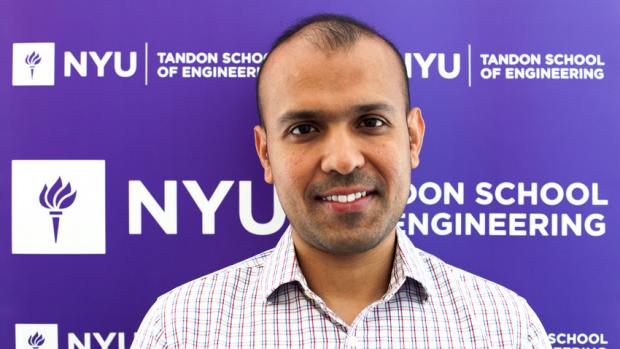NYU Tandon Professor Siddharth Garg is “Brilliant”
Cybersecurity Researcher Named to Popular Science Magazine’s “Brilliant 10” for His Innovations That Protect Microchips

Siddharth Garg, assistant professor of electrical and computer engineering
Popular Science magazine has named Siddharth Garg to its 15th annual Brilliant 10 list, a roundup of young scientists and engineers doing world-changing work. Garg, an assistant professor in NYU Tandon’s Department of Electrical and Computer Engineering, was recognized for his work in the field of hardware security, which focuses on outsmarting criminals’ attempts to build vulnerabilities into the chips that power everything from computers and smartphones to the systems that run cars, major utilities, public transportation, and nuclear facilities.
Popular Science likens Garg’s area of expertise to “the premise of a bad supervillain flick,” describing the all-too-real potential for tampering during the chip design and manufacturing process. In the past decade, chip production has moved from an “in-house,” closely guarded process to one that requires components to circle the globe as they are designed, fabricated, and ultimately installed in products. Where there was once little opportunity for outside vendors to access chip blueprints or circuitry, there are now multiple points at which malicious actors may intervene.
Garg, who joined NYU Tandon in 2014, was hailed for developing new strategies for safeguarding chip integrity. In 2015, he discovered serious vulnerabilities in the security of a popular method for camouflaging circuits to deter intellectual property theft. Common wisdom held that these so-called camouflaged gates could withstand thousands of years of hacking before their functionality was discovered. Garg’s findings showed that such gates could be reverse-engineered in mere minutes. He subsequently introduced a novel camouflaging scheme in which the functionality of a chip is dependent on small fluctuations in the concentration of impurities with which the silicon is doped. The optical tools used to “de-layer” a chip for IP theft would be unable to discern the functionality of a chip protected using this method.
Garg was also cited for a visionary technique of “split manufacturing” designed to foil attempts to compromise a chip during the fabrication process. Rather than giving foundries access to a complete chip blueprint, the design plan is split into pieces and divvied up between several foundries. It is far more difficult for a malicious actor to alter a circuit’s functionality without access to a full blueprint. Popular Science noted that while others have proposed split manufacturing schemes in the past, Garg is the first to devise mathematical methods of both splitting and reassembling components that can be implemented without prohibitive increases in manufacturing costs.
“We are very proud to see another member of the NYU Tandon faculty counted among the Brilliant 10,” said NYU Tandon President and Dean of Engineering Katepalli R. Sreenivasan. “Professor Garg is working in one of the most thrilling, complex, and impactful areas of research — there is simply no underestimating the importance of innovation in cybersecurity. We are especially pleased to see a national spotlight on the kind of work that not only advances a scientific field but contributes to the safety and security of society at large.”
Garg is the third current NYU Tandon faculty member to be named to the Brilliant 10. Others are Justin Cappos and Maurizio Porfiri. Nicole Abaid, who earned her doctorate in mechanical engineering in Porfiri’s lab and is now assistant professor at Virginia Tech, made the list in 2015.
“We at Popular Science were blown away by this group of the country's most promising young minds in science and engineering,” said executive editor Kevin Gray. “Solutions to the world's most pressing problems are in the hands of this year's Brilliant 10.”
The Brilliant 10 are featured in the October issue of Popular Science and at www.popsci.com/tags/brilliant-10.
Note: Images available at http://dam.poly.edu/?c=1804&k=f0d568e643
About the NYU Tandon School of Engineering
The NYU Tandon School of Engineering dates to 1854, when the New York University School of Civil Engineering and Architecture as well as the Brooklyn Collegiate and Polytechnic Institute (widely known as Brooklyn Poly) were founded. Their successor institutions merged in January 2014 to create a comprehensive school of education and research in engineering and applied sciences, rooted in a tradition of invention, innovation, and entrepreneurship and dedicated to furthering technology in service to society. In addition to its main location in Brooklyn, NYU Tandon collaborates with other schools within the country’s largest private research university and is closely connected to engineering programs in NYU Abu Dhabi and NYU Shanghai. It operates business incubators in downtown Manhattan and Brooklyn and an award-winning online graduate program.




